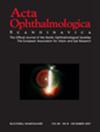Modified penetrating deep sclerectomy versus conventional trabeculectomy for the treatment of glaucoma: A 12-month randomized prospective study
Abstract
Purpose
To compare the surgical outcomes and adverse events of modified penetrating deep sclerectomy with conventional trabeculectomy.
Methods
A prospective randomized clinical study that successively recruited patients with moderate and advanced primary open-angle glaucoma (POAG) and primary angle closure glaucoma (PACG) in West China Hospital. The modified penetrating deep sclerectomy creates a small triangular intrascleral lake, which aims to reduce the risk of flap adhesion in conventional trabeculectomy and sudden hypotony associated with the dissection of a larger rectangular deep scleral flap. The primary effectiveness endpoint was the IOP by non-contact tonometer with or without medication use at each follow-up visit. The primary safety endpoint was the incidence of all complications during the study.
Results
A total of 19 patients (21 eyes) were randomized to modified deep sclerectomy and 21 patients (21 eyes) to conventional trabeculectomy. Age, sex ratio, pre-operative intraocular pressure (IOP) and the number of IOP-lowering medications used were comparable between the two groups. At the end of the follow-up period (12 months), IOPs were (15.52 ± 3.28) mmHg and (19.66 ± 4.01) mmHg in the modified deep sclerectomy and conventional trabeculectomy groups, respectively (p = 0.006). Deterioration of the visual field appeared in four eyes (19.0%) and seven eyes (33.3%) in the two groups (p = 0.33). At 12 months, the average areas of the aqueous outflow pathway were (0.67 ± 0.30) and (0.43 ± 0.26) mm2, demonstrating a significant difference (p = 0.016). Using 18 and 15 mmHg as the IOP criteria for surgical success, the modified penetrating deep sclerectomy group showed a higher overall success rate than the conventional trabeculectomy group at 12 months (18 mmHg: 80.95% vs 52.38%, Log Rank p = 0.033; 15 mmHg: 52.38% vs 4.75%, Log Rank p = 0.001). Complication rates were similar between the two groups (23.8% vs 33.3%, p = 0.55), and no sight-threatening complications were reported.
Conclusions
Modified deep sclerectomy shows superior efficacy in IOP control and maintenance of the outflow pathway opening, with comparable rates of adverse events, resulting in a higher overall success rate.

 求助内容:
求助内容: 应助结果提醒方式:
应助结果提醒方式:


